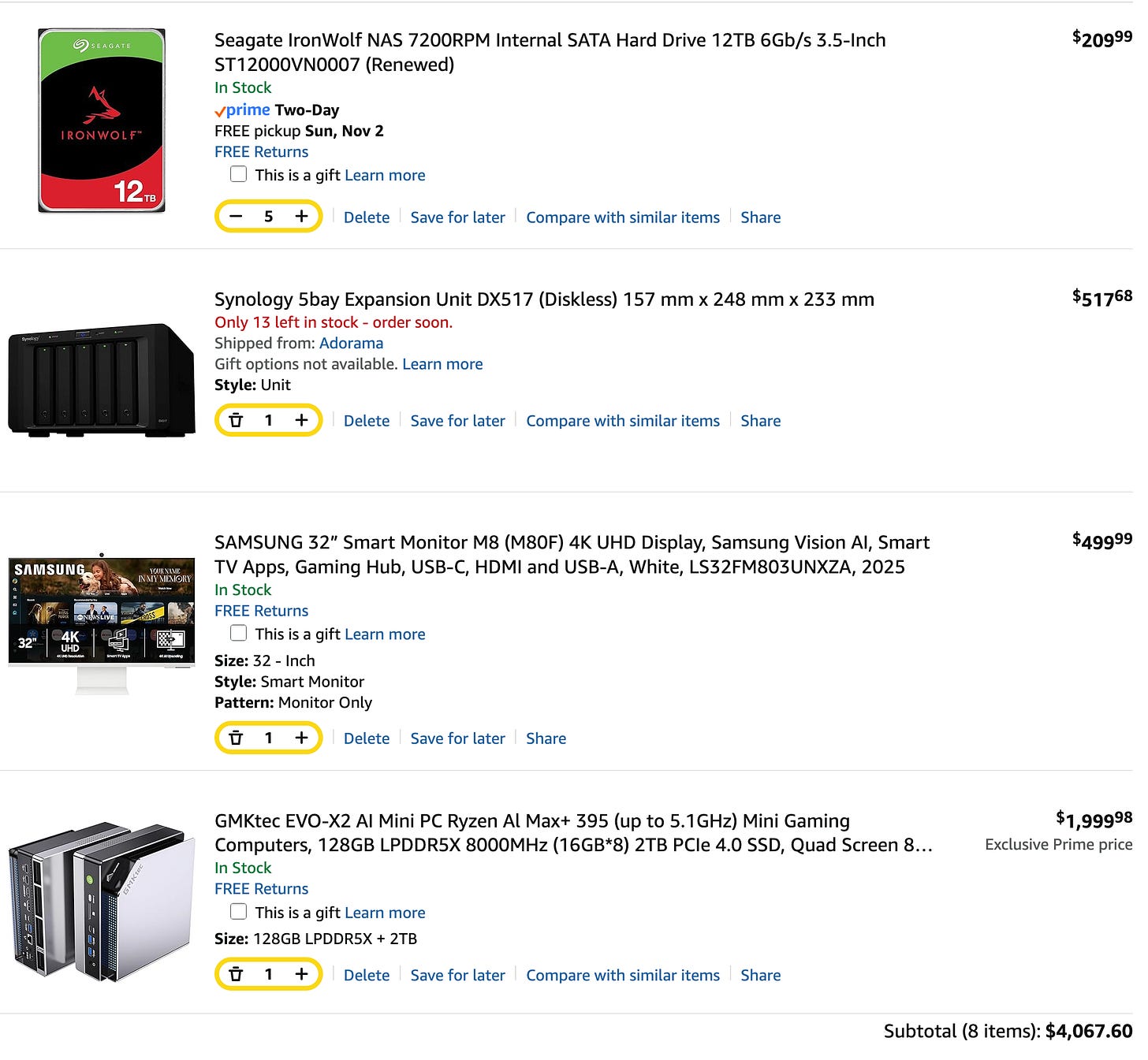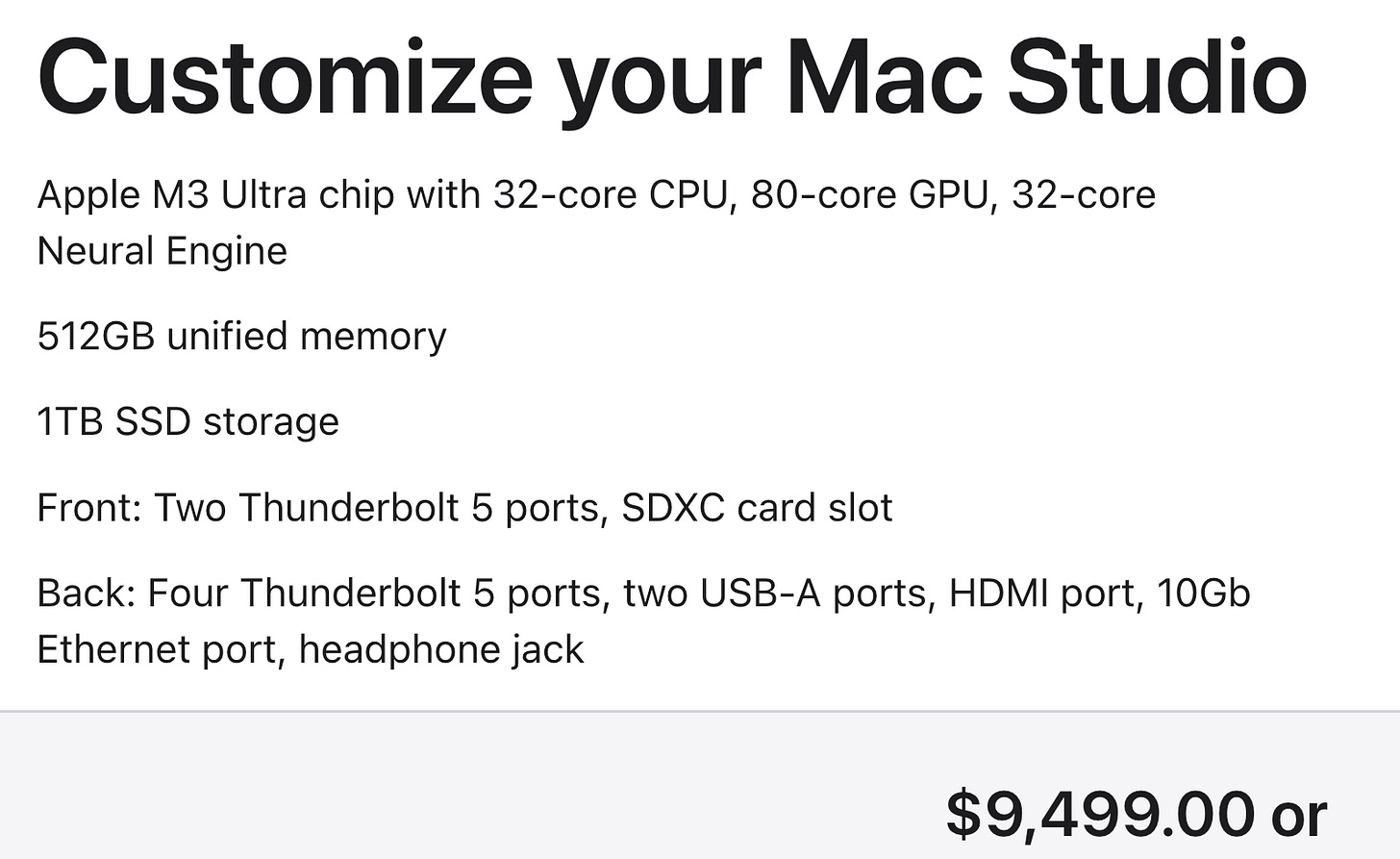The Wars Of Unification
The conflict that will define the next age.
If you use Google on the title of this article you’ll find things about Germany first, followed by Warhammer 40k, and if you keep digging you’ll get to the conflicts on the Korean peninsula in the 7th century, which is what I associate with the term. Hapkido is forty years in the rear view mirror, but this was a big influence in my teens.
We have a different unification problem today. The time of the discrete GPU for personal computers is at the beginning of its end. The demand for silicon at the high end is enormous and unified memory systems, which began life as the cheapest of the cheap seats, are now turning into … a quite desirable hybrid.
Let’s take a look at two sets of three options in this area.
Attention Conservation Notice:
Seems to be about hardware, but there’s geopolitics and philosophy and other weird trivia in here. Enter at your own risk.
Haves & Have-Nots:
There were crazed zealots wandering the halls of TechCrunch Disrupt, talking about how there will be people who get/have AI, and a massive underclass who missed the boat. They are … only a trifle extreme. I got to look at our comp plan today and there was a long debate about the pool of shares for recruiting additional staff. “If we succeed at all, we are not going to NEED more staff.”
You think this sounds all weird and airy fairy? Listen to Nate, people … because the investor class here in the Bay Area and looking for that unitary unicorn - a billion dollar company that has precisely ONE founder.
I’m comfortable, strolling with one foot in light and the other in shadow, here at the edge, where things that might be are busy becoming. What does this mean for the masses?
Sovereign Inference:
There are, at the geopolitical level, countries starting to build AI because they realize if they leave that capability in the hands of the U.S., they’re utterly wrecked. You, as a human likely inhabiting a developed country, are perhaps in not such a dire position, but look at what Nate said. Using AI fluently is going to be the “computer skills” of the prior century - the career dividing line.
You can get away with using ChatGPT (for some things), or Claude (for other things), and Google is coming on strong (for many things). I don’t care for Grok’s owner, so I avoid it, but I hear it’s good for what’s happening in the moment.
I hate renting when I could have stuff of my own to fondle and tune. I think what is happening is that a force akin to what drove gamers to have discrete GPUs is going to drive professionals to have some juice of their own.
Starting Small:
There’s a 16GB GPU sitting on the table behind me, waiting for a workstation with enough power to push it. The old workstation is just done, the older 6GB GPU in it is going to a coworker to support their three monitor setup, so their 16GB GPU can run free with AI tasks. A $481 spend is dramatically upgrading two of us. Hot on the heels of that, I spent $48 on a 4GB GPU, but it’s half height, half length, passive cooled, and meant for the tiny Dell Optiplex I was going to gift to someone else. This machine is becoming my conscience - it’s a model of what I expect I’ll encounter on the desktop of random humans using my software.
Assuming we get that A series funding, some of use are going to get new personal computers. Laptops don’t really count for SovCitInference work, it’s gotta be some sort of workstation. These are the choices in the 96GB - 128GB range at around $4,000. And they all feature unified memory …
Apple Mac Studio M3 Ultra:
This thing is an absolute rocket in terms of Macs, not the newest, but in the $4k class it offers a slamming 819GB/sec memory bandwidth. This is a decent choice for research, but the processor lacks the specialized data types like BrainFloat-16 or TensorFloat-32. Even so, it’s a very attractice machine for a developer’s desktop.
Nvidia DGX Spark:
Slow to arrive in the supply chain, we suspect due to issues integrating the Blackwell GPU and the twenty core ARM processor. Offers the same 5th gen tensor cores as my new GPU, but only 273GB/sec memory bandwidth. This adheres tightly to what you find in datacenters, but overall performance is going to be less than the Mac.
AMD Ryzen AI Max+ 395:
There are a variety of machines featuring the new AI Max+ 395 chip. These are the least capable, with 212GB/sec to 256GB/sec depending on sources, but they win on low power and low cost. You can get a pair of these machines for $4,000, or you can build yourself a fantastic workstation with 32TB of two disk fault tolerant NAS storage. This is the only machine of the three that offers the industry standard AMD64 Linux as an operating system choice.
Consumers would likely aim for the Apple, developers with need to bring things to the datacenter would cleave to the Spark, while the home enthusiast with multifaceted interests and a LOT of data would prefer the Max+ 395 solution.
Going Large:
What happens when you have $10,000 to spend? This changes things a bit.
Apple Mac Studio M3 Ultra:
This machine is still the champ, but you get 512GB of memory at this level, with that same 819GB/sec memory access.
Nvidia A6000 workstation:
The Nvidia RTX 6000 Blackwell with 96GB is down to $8,700 and you can get a nice HP workstation for $1,300. These machines offer AVX512 with Deep Learning extensions, so models that overflow the 96GB of GPU memory will still run.
Spark DGX Cluster:
You can connect two of the Spark DGX in a cluster. This is two 128GB machines with a (relatively) fast interconnect and enough cash left over for a nice monitor and NAS.
The Apple is an AMG Sedan, insanely fast, but insistently civilized on your desktop. The Blackwell system is a 2023 Challenger SRT Demon. It doesn’t even pretend to play nice, it’s all noise and heat. The Spark is … this is the equivalent of the oddball contraptions that people haul to Bonneville in an effort to “get the full five miles”. Unless you, or more likely your employer, have an AI focused datacenter in your hip pocket, this makes no sense.
My Personal Calculus:
If offered $4,000, being mindful that I have a 16GB Mac and a 16GB GPU handy … I could
Just get a 128GB Spark DGX
Spend $2,700 on a 64GB M4 Mac Studio and a pair of 24GB RTX 3090
Spend $2,500 on 48GB M4 Mac Studio and $1,500 on a 64GB AI Max+ 395.
Spend $2,000 on the 128GB AI Max+ 395 and suffer the 36GB M4 Mac Studio.
Spend $2,000 on the 128GB AI Max+ 395 and enjoy a 32GB M4 Mac Air.
Given my target of an Nvidia equipped datacenter combined with a need to keep an eye on developments around AMD’s fast rising Ryzen … I would likely end up with the last option, handing Pinky & Brain down to some other needy people.
If there was $10k just sitting there … I get the 128GB Spark DGX, the 128GB AI Max+ 395, and the Mac Studio M3Ultra. Again, Pinky and Brain move on, and the HP workstation’s heat and noise get relegated to the living room, since I just use it as a headless baby datacenter as is.
Your Personal Calculus:
Windows is objectively a terrible OS and as of today I don’t think there’s a unified memory solution with serious GPU performance. If you need a mobile consumer friendly thing, a 32GB 13” MacAir will set you back $1,600. If you’re happy with a Linux box at home the 64GB AI Max+ 395 is $1,500.
The cost of doing business in 2025 is a $140/month payment on a computer, unless you already have a 16GB or larger Mac, and at least one of the $20/month services like ChatGPT, Claude, or Perplexity. I am using two of the three daily and the only thing keeping me from Perplexity is that I’m already engaging in tail drop on my work queue.
Conclusion:
You have probably deduced out that Parabeagle is the basis for the pursuit of Series A funding. That may or may not be correct. The bigger picture is what Nate said in his video - an AI savvy A team will squish a whole battalion of regulars. So while I have work to do that is focused on the task at hand, but I am asked daily about what I’m doing to facilitate others becoming tier 1 operators.
This month I have to concoct a boot camp for people who are problem domain experts, but who are neither using the AI services, nor their own systems, to that tier 1 standard. Everybody’s an adult learner, the sort who will sample some reading, watch a couple videos, but who mostly just want to look over the shoulder of someone who’s already got the scuff marks one acquires climbing this learning curve. Tellingly, 16GB Apple computers are universal.
I had been hunting for the 512GB NVMe Windows 11 stick that came with my little HP EliteDesk G5, but I can’t find it, and I think this is maybe the universe telling me something. I am not going to touch Windows again until there is common hardware that does what the Apple products do.
So there you have it. I have to write a piece about Claude Camp, and that’s going to start promptly on the 3rd of November. Sadly, it’s gotta be paid subs only, since I’m expecting to do hands on tech support with anyone who chooses to follow this path.



